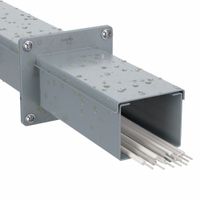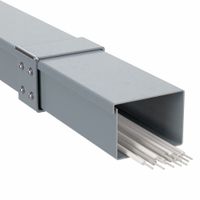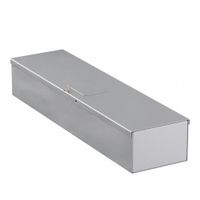Call +(254) 703 030 000 / 751 483 999 / 721 704 777
- Home
- Electrical
- Wire Cable Management
- Wireways
.....Read More
Frequently Asked Questions
What are wireways used for?
Wireways are used for organizing, protecting, and managing electrical wiring systems in various settings. They serve as enclosed channels that house electrical cables, providing a neat and efficient way to route wires from one point to another. This helps in maintaining an organized infrastructure, reducing clutter, and minimizing the risk of damage to the wires.
Wireways are typically made from materials like metal or plastic, offering protection against environmental factors such as moisture, dust, and physical impact. This is particularly important in industrial and commercial environments where wires may be exposed to harsh conditions. By safeguarding the wires, wireways help in preventing electrical hazards, ensuring safety for both equipment and personnel.
In addition to protection, wireways facilitate easy access for maintenance and upgrades. They often come with removable covers, allowing technicians to inspect, repair, or replace wires without dismantling the entire system. This accessibility is crucial for minimizing downtime and ensuring the efficient operation of electrical systems.
Wireways also play a role in compliance with electrical codes and standards, which often require proper management and protection of wiring systems. By using wireways, organizations can ensure they meet these regulatory requirements, avoiding potential fines and ensuring the safety and reliability of their electrical installations.
Overall, wireways are essential components in electrical systems, providing organization, protection, and accessibility, while also ensuring compliance with safety standards.
How do wireways protect electrical wiring?
Wireways protect electrical wiring by providing a secure, organized, and enclosed pathway for electrical conductors. They shield the wires from physical damage, such as abrasion, impact, and environmental factors like moisture, dust, and corrosive substances. By enclosing the wires, wireways prevent accidental contact with live conductors, reducing the risk of electrical shock and short circuits. They also help in maintaining the integrity of the wiring system by preventing tangling and facilitating easy maintenance and inspection. Additionally, wireways support heat dissipation, reducing the risk of overheating and potential fire hazards.
What materials are wireways made from?
Wireways are typically made from a variety of materials, each chosen for specific properties that suit different applications and environments. The most common materials include:
1. **Steel**: Often used for its strength and durability, steel wireways are typically galvanized or coated to prevent corrosion. They are suitable for industrial environments where mechanical protection is crucial.
2. **Aluminum**: Known for being lightweight and resistant to corrosion, aluminum wireways are often used in environments where weight is a concern, such as in aerospace or marine applications. They also offer good thermal conductivity.
3. **Stainless Steel**: This material is chosen for its excellent corrosion resistance and strength. Stainless steel wireways are ideal for harsh environments, including chemical plants and food processing facilities, where hygiene and resistance to corrosive substances are important.
4. **PVC (Polyvinyl Chloride)**: PVC wireways are non-conductive, lightweight, and resistant to moisture and many chemicals. They are often used in residential and commercial applications where electrical insulation and cost-effectiveness are priorities.
5. **Fiberglass**: Offering high resistance to corrosion and electrical insulation, fiberglass wireways are suitable for environments exposed to chemicals or extreme temperatures. They are also lightweight and non-magnetic.
6. **Polycarbonate**: This material is used for its impact resistance and clarity, making it suitable for applications where visibility of the contents is necessary. It is also resistant to UV radiation and weathering.
Each material offers distinct advantages, and the choice depends on factors such as environmental conditions, mechanical protection needs, weight considerations, and cost constraints.
How are wireways installed?
Wireways are installed by following a systematic process to ensure safety and functionality. First, a detailed plan is created, considering the layout and electrical requirements. The installation begins with marking the path on walls, ceilings, or floors where the wireway will be mounted.
Next, the mounting surface is prepared, ensuring it is clean and free of obstructions. Support brackets or hangers are installed at regular intervals along the marked path to provide stability. The wireway sections are then cut to the required lengths, if necessary, using appropriate tools to ensure clean edges.
The wireway sections are mounted onto the brackets or hangers, starting from one end and working towards the other. Each section is securely fastened using screws or bolts, ensuring alignment and continuity. If the wireway needs to change direction, elbows or tees are used to maintain the path.
Once the wireway is in place, the covers are removed to allow for cable installation. Cables are laid inside the wireway, ensuring they are organized and not overcrowded to prevent overheating. Cable ties or clips may be used to secure the cables in place.
After the cables are installed, the wireway covers are reattached, ensuring they are properly secured to protect the cables from external damage. Finally, the installation is inspected to ensure compliance with electrical codes and standards, verifying that all connections are secure and that the wireway is properly grounded if required.
Throughout the process, safety precautions are observed, including the use of personal protective equipment and adherence to electrical safety guidelines.
What are the different types of wireways?
Wireways are enclosed channels designed to protect and route electrical wiring. The different types of wireways include:
1. **Metallic Wireways**: Made from materials like steel or aluminum, these are robust and provide excellent protection against physical damage and electromagnetic interference. They are often used in industrial settings.
2. **Non-metallic Wireways**: Constructed from materials such as PVC or fiberglass, these are lightweight and resistant to corrosion. They are suitable for environments where moisture or chemicals are present.
3. **Surface-Mounted Wireways**: Installed on the surface of walls or ceilings, these wireways are easily accessible for maintenance and modifications. They are ideal for retrofitting in existing structures.
4. **Flush-Mounted Wireways**: Embedded within walls or ceilings, these provide a cleaner appearance as they are hidden from view. They are often used in new construction projects.
5. **Flexible Wireways**: Made from materials that allow bending, these wireways are used in applications where movement or vibration is present, such as in machinery or robotics.
6. **Wire Ducts**: These are open-top wireways that allow for easy insertion and removal of wires. They are commonly used in control panels and switchboards.
7. **Troughs**: Larger wireways that can accommodate a significant number of cables, often used in industrial settings for main power distribution.
8. **Raceways**: A broader category that includes wireways, raceways can be metallic or non-metallic and are used to route and protect cables in various environments.
9. **Cable Trays**: Although not enclosed like traditional wireways, cable trays support and organize large volumes of cables, often used in data centers and industrial facilities.
Each type of wireway is selected based on factors such as environmental conditions, installation requirements, and the level of protection needed.
What are the benefits of using wireways in industrial settings?
Wireways offer several benefits in industrial settings:
1. **Organization**: Wireways provide a structured path for cables, reducing clutter and making it easier to manage complex wiring systems. This organization simplifies maintenance and troubleshooting.
2. **Protection**: They shield cables from physical damage, dust, moisture, and chemical exposure, enhancing the longevity and reliability of electrical systems.
3. **Safety**: By enclosing wires, wireways minimize the risk of electrical hazards such as short circuits and accidental contact, ensuring a safer environment for workers.
4. **Flexibility**: Wireways can be easily modified or expanded to accommodate changes in the wiring system, supporting future upgrades or reconfigurations without significant disruption.
5. **Aesthetic Appeal**: They conceal cables, contributing to a cleaner and more professional appearance in industrial facilities.
6. **Compliance**: Wireways help meet regulatory standards and codes by providing a compliant method for cable management, which is crucial for inspections and certifications.
7. **Efficiency**: Streamlined cable management reduces installation time and labor costs, improving overall operational efficiency.
8. **Space Optimization**: By organizing cables vertically or horizontally along walls or ceilings, wireways free up valuable floor space for other industrial activities.
9. **Reduced Downtime**: Easier access to organized wiring systems means quicker repairs and less downtime during maintenance or emergencies.
10. **Cost-Effectiveness**: While there is an initial investment, the long-term savings from reduced maintenance, increased safety, and improved efficiency make wireways a cost-effective solution.
Overall, wireways enhance the functionality, safety, and efficiency of industrial electrical systems, making them an essential component in modern industrial infrastructure.
How do you choose the right wireway for a specific application?
To choose the right wireway for a specific application, consider the following factors:
1. **Environment**: Determine if the wireway will be used indoors or outdoors. For outdoor applications, select materials like stainless steel or aluminum that resist corrosion and weather conditions. For indoor use, steel or PVC may suffice.
2. **Material**: Choose the material based on environmental conditions and budget. Steel offers strength and durability, aluminum is lightweight and corrosion-resistant, and PVC is cost-effective and non-conductive.
3. **Size and Capacity**: Calculate the number and size of cables to ensure the wireway can accommodate them without overcrowding. Consider future expansion needs.
4. **Type of Wireway**: Decide between solid, ventilated, or ladder-type wireways. Solid wireways provide protection from dust and moisture, ventilated ones allow heat dissipation, and ladder types support heavy cables.
5. **Installation Requirements**: Assess the ease of installation and maintenance. Modular designs can simplify installation and allow for easy access during maintenance.
6. **Compliance and Standards**: Ensure the wireway meets relevant industry standards and codes, such as NEMA or IEC, for safety and performance.
7. **Aesthetic Considerations**: In visible areas, consider the appearance of the wireway. Choose finishes and colors that blend with the environment.
8. **Cost**: Balance the initial cost with long-term benefits. Higher upfront costs for durable materials may result in lower maintenance and replacement costs.
9. **Load and Support**: Ensure the wireway can support the weight of the cables and any additional loads. Check for appropriate mounting and support options.
10. **Special Features**: Consider additional features like hinged covers for easy access, knockouts for cable entry, or dividers for cable separation.
By evaluating these factors, you can select a wireway that meets the specific needs of your application effectively.



